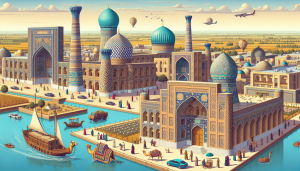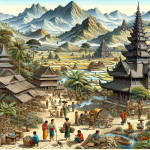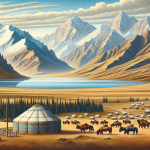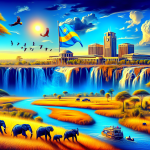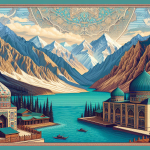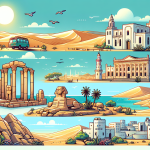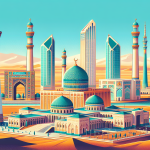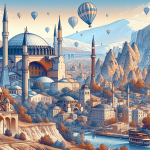Discovering the Rich Tapestry of Uzbekistan: A Journey Through Time and Culture
Nestled in the heart of Central Asia, Uzbekistan is a land steeped in history, culture, and breathtaking landscapes. Often overlooked by travelers seeking more mainstream destinations, Uzbekistan offers a unique blend of ancient architecture, vibrant markets, and a rich cultural tapestry that dates back thousands of years. As a travel blogger passionate about uncovering hidden gems, I invite you to embark on a journey through Uzbekistan, exploring its storied past, diverse traditions, and scenic beauty. From the bustling streets of Tashkent to the ancient Silk Road cities of Samarkand, Bukhara, and Khiva, Uzbekistan promises an unforgettable adventure for those willing to delve into its myriad wonders. In this comprehensive guide, we’ll uncover the best places to visit, the most delicious dishes to try, and the cultural experiences that make Uzbekistan a must-visit destination. Whether you’re a history buff, a foodie, or simply a curious traveler, Uzbekistan has something to offer everyone. Let’s dive into the heart of Central Asia and discover why Uzbekistan should be on every traveler’s bucket list.
Tashkent: The Modern Metropolis
A Blend of Old and New
Tashkent, the capital city of Uzbekistan, serves as the perfect starting point for your Uzbek adventure. This bustling metropolis is a fascinating blend of modernity and tradition, offering a glimpse into the country’s rapid development while retaining its historical charm. Begin your exploration in the heart of the city at Independence Square, a symbol of Uzbekistan’s sovereignty and a hub of political and cultural activity. Here, you’ll find impressive monuments, fountains, and beautifully landscaped gardens that provide a serene escape from the city’s hustle and bustle.
Must-Visit Attractions in Tashkent
One of the city’s highlights is the Chorsu Bazaar, a vibrant market that has been a center of trade for centuries. Wander through the maze of stalls selling everything from fresh produce and spices to traditional crafts and textiles. The bazaar is a sensory overload, with the tantalizing aroma of spices and the vibrant colors of fabrics creating a feast for the senses. Don’t forget to sample some local delicacies, such as plov (a rice dish with meat and vegetables) and samsa (savory pastries), as you explore the market.
Another must-visit attraction is the Khast Imam Complex, an important religious site that houses one of the oldest Qurans in the world. The complex features stunning Islamic architecture, with intricately designed mosques and madrasas that offer a glimpse into Uzbekistan’s rich religious heritage. For a touch of modernity, head to the Tashkent TV Tower, the tallest structure in Central Asia, which offers panoramic views of the city and beyond.
Samarkand: The Jewel of the Silk Road
Historical Significance
No visit to Uzbekistan is complete without a trip to Samarkand, one of the most famous cities along the ancient Silk Road. Known as the “Crossroad of Cultures,” Samarkand boasts a rich history that dates back over 2,500 years. The city’s strategic location made it a melting pot of cultures, where traders, scholars, and artisans from different parts of the world converged, leaving behind a legacy of architectural and cultural marvels.
Architectural Wonders
Samarkand’s most iconic landmark is the Registan Square, a majestic ensemble of three madrasas (Islamic schools) that showcase the pinnacle of Islamic architecture. The intricate tilework, grand courtyards, and towering minarets of the Ulugh Beg, Sher-Dor, and Tilya-Kori madrasas are a testament to the city’s architectural brilliance. As you wander through the square, you’ll be transported back in time, imagining the bustling activity of scholars and traders who once thrived here.
Another architectural gem is the Shah-i-Zinda, a necropolis that houses a series of mausoleums adorned with some of the finest tilework in the Islamic world. The vibrant blue and turquoise tiles create a mesmerizing visual spectacle that is both awe-inspiring and humbling. Don’t miss the Gur-e Amir Mausoleum, the final resting place of the great conqueror Timur (Tamerlane). The mausoleum’s elegant design and exquisite craftsmanship make it a fitting tribute to one of history’s most formidable leaders.
Bukhara: The City of a Thousand Monuments
A Living Museum
Bukhara, another key city along the Silk Road, is often referred to as a “living museum” due to its well-preserved historical architecture and cultural heritage. The city’s old town, a UNESCO World Heritage site, is a labyrinth of narrow streets, ancient mosques, and bustling bazaars that transport visitors back to the days of the Silk Road.
Top Attractions in Bukhara
Start your exploration at the Lyabi-Hauz, a picturesque square centered around a tranquil pool, surrounded by historic buildings and shaded by ancient mulberry trees. This area is a popular gathering spot for locals and tourists alike, offering a glimpse into the city’s vibrant social life. Nearby, you’ll find the Nadir Divan-Begi Khanaka, a stunning example of 17th-century Islamic architecture, with its intricate tilework and grand portal.
The Ark Fortress, a massive citadel that once served as the residence of Bukhara’s rulers, is another must-visit site. Inside the fortress, you’ll find a museum that showcases the city’s rich history, with exhibits ranging from ancient artifacts to royal treasures. For a spiritual experience, visit the Bolo Haouz Mosque, known for its elegant wooden pillars and beautifully decorated prayer hall.
Khiva: A Step Back in Time
The Walled City
Khiva, a city that feels like a step back in time, is one of the best-preserved ancient cities in Central Asia. The city’s historic center, known as Itchan Kala, is a UNESCO World Heritage site surrounded by imposing walls and filled with a wealth of historic buildings. Walking through the narrow streets of Itchan Kala, you’ll feel as though you’ve been transported to a different era.
Historic Landmarks in Khiva
One of the most iconic landmarks in Khiva is the Kalta Minor Minaret, a strikingly short and unfinished minaret covered in vibrant blue tiles. The minaret, intended to be the tallest in Central Asia, was never completed, but its unique appearance has made it one of the city’s most recognizable symbols. Another must-see site is the Kunya Ark, the former residence of Khiva’s rulers, which offers stunning views of the city from its watchtower.
The Juma Mosque, with its forest of wooden columns, is another architectural marvel that should not be missed. The mosque’s serene atmosphere and intricate design make it a perfect spot for quiet reflection. For a glimpse into Khiva’s rich history, visit the Tash Hauli Palace, a grand complex that once served as the residence of the Khan. The palace’s beautifully decorated rooms and courtyards provide a fascinating insight into the opulent lifestyle of Khiva’s rulers.
Experiencing Uzbek Culture and Cuisine
Traditional Crafts
Uzbekistan is renowned for its rich tradition of craftsmanship, with artisans producing everything from intricate ceramics and textiles to stunning jewelry and woodwork. In cities like Samarkand and Bukhara, you’ll find numerous workshops and studios where you can watch skilled craftsmen at work and purchase unique souvenirs to take home. One of the most famous crafts is suzani embroidery, a traditional form of needlework that features vibrant floral and geometric patterns.
Culinary Delights
No trip to Uzbekistan would be complete without indulging in the country’s delicious cuisine. Uzbek food is a flavorful blend of Central Asian, Middle Eastern, and Russian influences, with an emphasis on fresh ingredients and aromatic spices. One of the most iconic dishes is plov, a hearty rice dish cooked with meat, vegetables, and spices, often garnished with raisins and nuts. Each region has its own variation of plov, so be sure to try different versions as you travel through the country.
Another must-try dish is lagman, a noodle soup made with hand-pulled noodles, vegetables, and meat, flavored with a savory broth. For a taste of traditional street food, sample samsa, delicious pastries filled with meat, onions, and spices, baked to golden perfection. Don’t forget to try shashlik, skewered and grilled meat that is often served with fresh bread and salad.
Festivals and Traditions
Uzbekistan is a country with a rich calendar of festivals and cultural events that offer a unique insight into the nation’s traditions and customs. One of the most important celebrations is Navruz, the Persian New Year, which takes place in March and marks the arrival of spring. During Navruz, cities and towns come alive with music, dance, and feasting, as people gather to celebrate the renewal of nature and the start of a new year.
Another significant event is the Silk and Spices Festival in Bukhara, which takes place in late May or early June. This festival celebrates the city’s rich heritage as a center of trade and craftsmanship, with colorful parades, traditional music and dance performances, and a bustling market where you can purchase a wide variety of local goods. For a glimpse into the nomadic traditions of Uzbekistan, visit the Boysun Bahori Festival, held in the mountainous region of Boysun. This festival showcases traditional music, dance, and storytelling, offering a fascinating insight into the region’s unique cultural heritage.
Practical Travel Tips for Uzbekistan
Getting There and Getting Around
Uzbekistan is well-connected by air, with international flights arriving at Tashkent International Airport from major cities around the world. Once in the country, you can travel between cities by train, bus, or domestic flights. The Uzbekistan Railways network is an efficient and comfortable way to travel, with high-speed trains connecting Tashkent, Samarkand, Bukhara, and other major cities. For a more budget-friendly option, long-distance buses and shared taxis are also available.
Accommodation
Uzbekistan offers a wide range of accommodation options to suit every budget and preference. In major cities like Tashkent, Samarkand, and Bukhara, you’ll find everything from luxury hotels and boutique guesthouses to budget-friendly hostels and homestays. For a more authentic experience, consider staying in a traditional Uzbek house, where you can enjoy warm hospitality and delicious home-cooked meals.
Safety and Health
Uzbekistan is generally a safe country for travelers, with low levels of crime and a friendly, welcoming population. However, it’s always important to take standard precautions, such as keeping an eye on your belongings and avoiding walking alone at night in unfamiliar areas. In terms of health, tap water is not always safe to drink, so it’s advisable to stick to bottled or boiled water. Make sure to carry any necessary medications with you, as pharmacies may not always stock the same brands or formulations as in your home country.
Local Customs and Etiquette
Uzbekistan is a country with a rich cultural heritage and deep-rooted traditions, so it’s important to be respectful of local customs and etiquette. When visiting religious sites, dress modestly and remove your shoes before entering. It’s also customary to greet people with a warm smile and a handshake, and to use your right hand when giving or receiving items. When dining in a local home, it’s polite to accept food and drink when offered, and to express your appreciation for your host’s hospitality.
Conclusion
Uzbekistan is a destination that offers a truly unique and enriching travel experience. With its rich history, stunning architecture, vibrant markets, and warm hospitality, this Central Asian gem has something to offer every traveler. Whether you’re exploring the bustling streets of Tashkent, marveling at the architectural wonders of Samarkand, wandering through the ancient alleys of Bukhara, or stepping back in time in Khiva, you’ll be captivated by the country’s beauty and charm. So pack your bags, and get ready to embark on an unforgettable journey through the heart of Central Asia. Discover the magic of Uzbekistan, and let its rich tapestry of history and culture leave an indelible mark on your travel memories.
